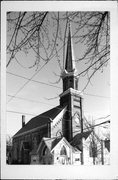| Additional Information: | A 'site file' exists for this property. It contains additional information such as correspondence, newspaper clippings, or historical information. It is a public record and may be viewed in person at the Wisconsin Historical Society, State Historic Preservation Office.
This church was the second building constructed for St. Mark's Lutheran Church. St. Mark's Church was organized by the Rev. Christian Sans in 1855 as the German Evangelical Lutheran Church. It was an alternative German Lutheran church to St. Luke's (at that time a Free German Church and not fully affiliated with the Lutheran church) and St. John's, the conservative Missouri Synod church. The Rev. Sans heavily influenced the leanings of St. Mark's and the church was not originally affiliated with any Lutheran Synod. The congregation built their first church at Sixth St. and Jones (demolished, 1987). Within a few years of the congregation's founding, a schism developed within the church involving a disagreement with Sans. Sans was released as pastor and at that time the church established a definitive Lutheran doctrine and liturgy. In 1861 they joined the Wisconsin synod and established themselves as a leader in this synod. The congregation established a German prochial school and was instrumental in founding and operating the Wisconsin Synod's college, Northwestern College. In 1888 the church built the present church building and continued to use their old church as a hall until the recent past, when it was, unfortunately, demolished. Their two historic school buildings are also not extant, and the church had an addition made in 1971. St. Mark's has continued to be a particularly German-influenced church and up to the present time some special services are still given in German.
St. Mark's Church is significant for local history under National Register criterion A because it is associated with the German settlement in Watertown.
St. Mark's was a large and important church in Watertown's German community. Originally a reflection of its first pastor, Rev. Sans, it soon became a large and influential Lutheran congregation. The church was and is the most important of the Wisconsin Synod Lutheran congregations in Watertown. The church was also important in the establishment and maintenance of the Northwestern College, the Wisconsin Synod college still in operation today as a preparatory school and college. Because it was a significant ethnic German organization which had considerable influence on German culture and education, St. Mark's church is an important historical landmark in the community. Until recently, the original St. Mark's Church still stood and probably was the most historically significant of the building's occupied by the Church. However, due to its recent demolition, the only remaining historic resources affiliated with this important ethnic congregation is this building, which has taken on considerable additional significance for this reason.
Dominated by a slightly projecting square entrance tower topped by an octagonal belfry and tall spire, this steel gable roofed church built in 1888 exhibits pointed arched with wooden tracery and brick voussoirs, a gabled open side entrance and a five sided apse on the east end. The cream brick surfaces are articulated by stepped brick butresses along the side elevation and on the corners, corbel trim along the gable and the eaves and brick moulding around the pointed arch widnows. A small rose window with cruciform tracery and blind arches along the top of the ornament of the tower. Wooden panels decorated with the "rising sun" motif ornament the base of the steeple that is covered by green tile arranged in geometric patterns.
A cream brick vestibule with three pointed arch entrances as well as a side entrance was added to the facade of the church in 1970.
St. Mark's Evangelical Lutheran Church was a significant example of the Gothic Revival style. The alteration of the entrances and addition of the large vestibule has compromised the integrity of the Gothic revival design. However, if the church undergoes restoration, St. Mark's should be reevaluated for architectural significance. Better extant examples of 19th century Gothic style church architecture with better integrity in the city are St. Paul's Episcopal Church at 413 So. Second (42-30) and St. Bernard's Church at 100 So. Church St. (54-2). |
|---|





